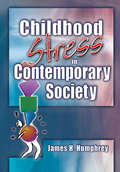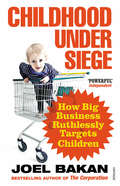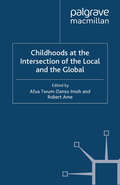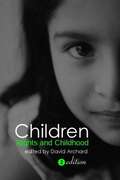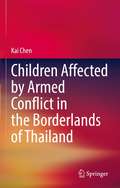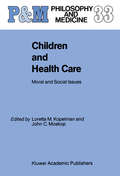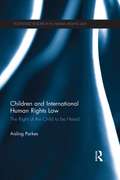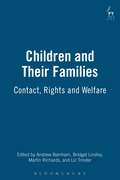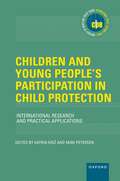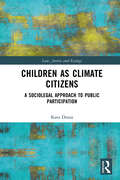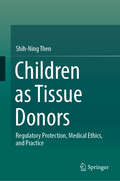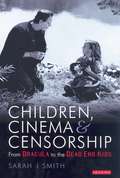- Table View
- List View
Childhood Stress in Contemporary Society
by James H HumphreyDon&’t let your own reaction to stress negatively affect the children in your care! With new evidence indicating that undesirable stress is likely to have its roots in childhood, Childhood Stress in Contemporary Society is a much-needed resource for anyone who works with children. An authority in the field of stress education, Dr. Jam
Childhood Under Siege: How Big Business Ruthlessly Targets Children
by Joel BakanThere is now an estimated 1 trillion dollars of buying power in the hands of children.Tens of millions of children world-wide are prescribed psychotropic drugs today, compared to close to none in 1980.Food and drink industries spend billions each year marketing junk food to children.This is the story of how big businesses are transforming our children into obsessive and narcissistic mini-consumers, media addicts and pharmaceutical industry guinea pigs. In this insightful and chilling exploration, Joel Bakan throws a brilliant light on the ruthless manipulation of children and on our failure to protect them.
Childhoods at the Intersection of the Local and the Global (Studies in Childhood and Youth)
by Afua Twum-Danso Imoh and Robert AmeChildhoods at the Intersection of the Local and the Global examines the imposition of the modern Western notion of childhood, which is now deemed as universal, on other cultures and explores how local communities react to these impositions in various ways such as manipulation, outright rejection and acceptance. The book discusses childhoods in different regions of the world and boasts a range of contributors from several academic disciplines such as Sociology, Social Work, Education, Anthropology, Criminology and Human Rights, who are experts on the regions they discuss. The book argues against the notion of a universal childhood and illustrates that different societies around the world have different notions of childhood. This book is recommended reading for students, scholars and practitioners working with children in the Global South as well as internationally.
Children: Rights And Childhood
by David ArchardThird / 3rd edition. Children: Rights and Childhood is widely regarded as the first book to offer a detailed philosophical examination of children's rights. Drawing on a wide variety of sources from law and literature to politics and psychology, David Archard provides a clear and accessible introduction to a topic that has assumed increasing relevance since the book's first publication. Divided clearly into three parts, Children: Rights and Childhood covers key topics such as: John Locke's writings on children Philippe Aries's Centuries of Childhood key texts on children's liberation and rights a child's right to vote and to sexual choice the rights of parents and the state over children defining and understanding child abuse. The second edition has been fully revised and updated including a new preface, a new chapter on children's moral and legal rights, taking into account the United Nations Convention on the Rights of the Child.
Children Affected by Armed Conflict in the Borderlands of Thailand
by Kai ChenThis book explores how children have been affected by armed conflict in the borderlands of Thailand, particularly in the region abutting the Thailand-Myanmar border, and in the most southern part of Thailand. The author argues that the Thai government has made great efforts to protect children from armed conflict in these borderlands. The author analyzes the obstacles facing the Thai government in protecting children from armed conflict in the borderlands, and advances alternative solutions for how the Thai government might better protect children from armed conflict in the foreseeable future. This book not only opens a window for future research on children affected by armed conflict in the borderlands of Thailand and beyond, but also contributes to the breadth of perspective and depth of expertise in related fields, such as studies of human insecurity. It is relevant to scholars, graduate students, and policymakers interested in the impact of armed conflict on children.
Children and Cross-Examination: Time to Change the Rules?
by J R Spencer Michael LambIn 2009, Stephen Barker was convicted of rape on the evidence of a little girl who was four-and-a-half years old at the trial, and about three-and-a-half when first interviewed by the police. The high point of the proceedings was the child's appearance as a live witness in order for Barker's counsel to attempt a cross-examination.This case focused attention on the need, imposed by current English law, for even tiny children to come to court for a live cross-examination. In 1989, the Pigot Committee proposed a scheme under which the whole of a young child's evidence, including cross-examination, would be obtained out of court and in advance of trial. In 1999 a provision designed to give effect to this was included in the Youth Justice and Criminal Evidence Act, but it has not yet been brought into force.The full Pigot proposal was implemented, however, in Western Australia, and similar schemes operate in a number of European jurisdictions. This book of essays examines a number of these schemes, and argues the case for further reforms in the UK.
Children and Cross-Examination: Time to Change the Rules?
by John R Spencer Michael E LambIn 2009, Stephen Barker was convicted of rape on the evidence of a little girl who was four-and-a-half years old at the trial, and about three-and-a-half when first interviewed by the police. The high point of the proceedings was the child's appearance as a live witness in order for Barker's counsel to attempt a cross-examination.This case focused attention on the need, imposed by current English law, for even tiny children to come to court for a live cross-examination. In 1989, the Pigot Committee proposed a scheme under which the whole of a young child's evidence, including cross-examination, would be obtained out of court and in advance of trial. In 1999 a provision designed to give effect to this was included in the Youth Justice and Criminal Evidence Act, but it has not yet been brought into force.The full Pigot proposal was implemented, however, in Western Australia, and similar schemes operate in a number of European jurisdictions. This book of essays examines a number of these schemes, and argues the case for further reforms in the UK.
Children and Health Care: Moral and Social Issues (Philosophy and Medicine #33)
by Loretta M. Kopelman John C. MoskopBefore a separate Department of Medical Humanities was formed, the editors of this volume were faculty members of the Department of Pediatrics at our medical school. Colleagues daily spoke of the moral and social problems of children's health care. Our offices were near the examining rooms where children had their bone-marrow procedures done. Since this is a painful test, we often heard them cry. The hospital floor where the sickest children stayed was also nearby. The physicians, nurses, and social workers believed that children's health care needs were not being met and that more could and should be done. Fewer resources are available for a child than for an adult with a comparable illness, they said. These experiences prompted us to prepare this volume and to ask whether children do get their fair share of the health care dollar. Since the question "What kind of health care do we owe to our children?" is complex, responses should be rooted in many disciplines. These include philosophy, law, public policy and, of course, the health professions. Representing all of these disciplines, contributors to this volume reflect on moral and social issues in children's health care. The last hundred years have brought great changes in health care tor children. The specialty of pediatrics developed during this period, and with it, a new group of advocates for children's health care. Women's suffrage gave a political boost to the recognition of children's special health needs.
Children and International Human Rights Law: The Right of the Child to be Heard (Routledge Research in Human Rights Law)
by Aisling ParkesThe United Nations Convention on the Rights of the Child 1989 is one of the most highly ratified human rights treaties in the world, with 192 states currently signed up to it. Article Twelve is fundamental to the Convention and states that all children capable of forming views have the right to express those views, and recognises that all children have the right to be heard in any judicial and administrative proceedings affecting them. This book explores the historical and theoretical background to Article Twelve, and examines the various models of participation which have been created to facilitate a better understanding of this provision. Aisling Parkes analyzes the extent to which Article Twelve has been implemented under international law, and in domestic law, as well as setting-out recommendations for the most effective ways of implementing Article Twelve in all areas of children’s lives.
Children and International Human Rights Law: The Right of the Child to be Heard (Routledge Research in Human Rights Law)
by Aisling ParkesThe United Nations Convention on the Rights of the Child 1989 is one of the most highly ratified human rights treaties in the world, with 192 states currently signed up to it. Article Twelve is fundamental to the Convention and states that all children capable of forming views have the right to express those views, and recognises that all children have the right to be heard in any judicial and administrative proceedings affecting them. This book explores the historical and theoretical background to Article Twelve, and examines the various models of participation which have been created to facilitate a better understanding of this provision. Aisling Parkes analyzes the extent to which Article Twelve has been implemented under international law, and in domestic law, as well as setting-out recommendations for the most effective ways of implementing Article Twelve in all areas of children’s lives.
Children and the European Court of Human Rights
by Claire Fenton-GlynnThe European Convention on Human Rights is one of the most influential human rights documents in existence, in terms of its scope, impact, and jurisdiction. Yet it was not drafted with children, let alone children's rights, in mind. Nevertheless, the European Court of Human Rights has developed a large body of jurisprudence regarding children, ranging from areas such as juvenile justice and immigration, to education and religion, and the protection of physical integrity. Its influence in the sphere of family law has been profound, in particular in the attribution of parenthood, and in cases concerning child abduction, child protection, and adoption. This book provides a comprehensive and detailed overview of the jurisprudence of the Court as it relates to children, highlighting its many achievements in this field, while also critiquing its ongoing weaknesses. In doing so, it tracks the evolution of the Court's treatment of children's rights, from its inauspicious and paternalistic beginnings to an emerging recognition of children's individual agency.
Children and the European Court of Human Rights
by Claire Fenton-GlynnThe European Convention on Human Rights is one of the most influential human rights documents in existence, in terms of its scope, impact, and jurisdiction. Yet it was not drafted with children, let alone children's rights, in mind. Nevertheless, the European Court of Human Rights has developed a large body of jurisprudence regarding children, ranging from areas such as juvenile justice and immigration, to education and religion, and the protection of physical integrity. Its influence in the sphere of family law has been profound, in particular in the attribution of parenthood, and in cases concerning child abduction, child protection, and adoption. This book provides a comprehensive and detailed overview of the jurisprudence of the Court as it relates to children, highlighting its many achievements in this field, while also critiquing its ongoing weaknesses. In doing so, it tracks the evolution of the Court's treatment of children's rights, from its inauspicious and paternalistic beginnings to an emerging recognition of children's individual agency.
Children and the European Union: Rights, Welfare and Accountability (Modern Studies in European Law)
by Helen StalfordThis book examines in detail the status of children in the EU. Drawing on a range of disciplinary perspectives, including the sociology of childhood and human rights discourse, it offers a critical analysis of the legal and policy framework underpinning EU children's rights across a range of areas, including family law, education, immigration and child protection.Traditionally children's rights at this level have been articulated primarily in the context of the free movement of persons provisions, inevitably restricting entitlement to migrant children of EU nationality. In the past decade, however, innovative interpretations of EU law by the Court of Justice, coupled with important constitutional developments, have prompted the development of a much more robust children's rights agenda. This culminated in the incorporation of a more explicit reference to children's rights in the Lisbon Treaty, followed by the Commission's launch, in February 2011, of a dedicated EU 'Agenda' to promote and safeguard the rights of the child. The analysis presented in this book therefore comes at a pivotal point in the history of EU children's rights, providing a detailed and critical overview of a range of substantive areas, and making an important contribution to international children's rights studies.
Children and the European Union: Rights, Welfare and Accountability (Modern Studies in European Law #32)
by Helen StalfordThis book examines in detail the status of children in the EU. Drawing on a range of disciplinary perspectives, including the sociology of childhood and human rights discourse, it offers a critical analysis of the legal and policy framework underpinning EU children's rights across a range of areas, including family law, education, immigration and child protection.Traditionally children's rights at this level have been articulated primarily in the context of the free movement of persons provisions, inevitably restricting entitlement to migrant children of EU nationality. In the past decade, however, innovative interpretations of EU law by the Court of Justice, coupled with important constitutional developments, have prompted the development of a much more robust children's rights agenda. This culminated in the incorporation of a more explicit reference to children's rights in the Lisbon Treaty, followed by the Commission's launch, in February 2011, of a dedicated EU 'Agenda' to promote and safeguard the rights of the child. The analysis presented in this book therefore comes at a pivotal point in the history of EU children's rights, providing a detailed and critical overview of a range of substantive areas, and making an important contribution to international children's rights studies.
Children and the Law: An Interdisciplinary Approach with Cases, Materials and Comments
by Katherine Hunt FederleThe study and practice of juvenile law is inherently interdisciplinary--a successful practitioner must understand not only the legal implications in the field, but also have a solid grounding in child psychology, child development, neuroscience, sociology, criminology, and social work. The best child-advocates in the law have a firm familiarity with and understanding of the value these other disciplines provide. Children and the Law is a unique coursebook that will revolutionize the way students learn and apply juvenile law. By incorporating the interdisciplinary topics necessary to understand the best practices in child law, author Katherine Federle has carefully selected a vast array of articles, studies, research, cases and statutes that allow students to best understand the law and also help bridge the divide between theory and practice. The book is separated into four main sections: Children and Crime, Children and Protection, Children and Restraints on Freedom, and Children and Decision-Making. Each section in Children and the Law also includes a series of questions, exercises, and problems that encourage students to critically examine legal doctrine and policy in light of available scientific and socio-scientific scholarship.
Children and the Law: An Interdisciplinary Approach with Cases, Materials and Comments
by Katherine Hunt FederleThe study and practice of juvenile law is inherently interdisciplinary--a successful practitioner must understand not only the legal implications in the field, but also have a solid grounding in child psychology, child development, neuroscience, sociology, criminology, and social work. The best child-advocates in the law have a firm familiarity with and understanding of the value these other disciplines provide. Children and the Law is a unique coursebook that will revolutionize the way students learn and apply juvenile law. By incorporating the interdisciplinary topics necessary to understand the best practices in child law, author Katherine Federle has carefully selected a vast array of articles, studies, research, cases and statutes that allow students to best understand the law and also help bridge the divide between theory and practice. The book is separated into four main sections: Children and Crime, Children and Protection, Children and Restraints on Freedom, and Children and Decision-Making. Each section in Children and the Law also includes a series of questions, exercises, and problems that encourage students to critically examine legal doctrine and policy in light of available scientific and socio-scientific scholarship.
Children and Their Families: Contact, Rights and Welfare
by Andrew Bainham Bridget Lindley Martin Richards Liz TrinderThis book is concerned with the regulation of family relationships,in particular the issue of openness and contact in the many different family situations in which it may arise. The shift towards a presumption of contact, and its articulation within diverse fields of family law and practice raises a whole series of questions which this book seeks to explore. For example: Why has the contact presumption emerged? What is meant by contact, and with whom. What is the value and purpose of it? What makes it work or not work? What is the role of law and other forms of external intervention in promoting, regulating or facilitating contact and to what extent should 'familial' relationships be subject to state regulation? More broadly, what can we infer about current conceptualisations of family, parenting (and the relative importance of social and biological parenthood) and childhood from policy and practice towards contact?These and other questions were explored in a series of seminars organised by the Cambridge Socio-Legal Group in 2002. The book is the product of these seminars.Andrew Bainham, Belinda Brooks-Gordon, Ann Buchanan, Shelley Day Sclater, Judy Dunn, John Eekelaar, Bob Geldof, Jonathan Herring, Claire Hughes, Joan Hunt, Adrian James, Julie Jessop, Felicity Kaganas, Bridget Lindley, Mavis Maclean, Joanna Miles, Katrin Mueller-Johnson, Elsbeth Neil, Jan Pryor, Martin Richards, Bob Simpson, Donna Smith, Liz Trinder
Children and Young People's Participation in Child Protection: International Research and Practical Applications (INTERNATIONAL POLICY EXCHANGE SERIES)
by Katrin Križ Mimi PetersenChildren's participation in child protection has become a burgeoning field of interest for scholars and practitioners in the field of social work, and yet there is no edited volume that weaves together recent international contributions on the topic. This volume fills that gap, beginning with the assumption that children can and should have agency in decisions that affect their lives. Child protection is understood as protection from violence in the family and from violence in wider society. Children and youth may encounter public child protection systems in several instances: during child protection investigations, when children receive support services, during decisions about children's removals from home, and when children are in foster, kin, or residential care. Children may experience systemic violence as a lack of personal and economic security, a lack of access to education, and other factors. This book features pathways to children and young people's collective participation in changing child protection policies and services in multiple countries through examples of participatory research and practices promoting children and young people's participation in child protection. It highlights the change actions and voices of empowered and marginalized children and youth in various international contexts. The global examples featured in this volume can serve as an inspiration for children and youth, children's rights activists, child protection practitioners, students, scholars, and public policymakers to initiate, design, and implement participatory child protection policies and practices.
Children and Young People's Participation in Child Protection: International Research and Practical Applications (INTERNATIONAL POLICY EXCHANGE SERIES)
by Katrin Križ Mimi PetersenChildren's participation in child protection has become a burgeoning field of interest for scholars and practitioners in the field of social work, and yet there is no edited volume that weaves together recent international contributions on the topic. This volume fills that gap, beginning with the assumption that children can and should have agency in decisions that affect their lives. Child protection is understood as protection from violence in the family and from violence in wider society. Children and youth may encounter public child protection systems in several instances: during child protection investigations, when children receive support services, during decisions about children's removals from home, and when children are in foster, kin, or residential care. Children may experience systemic violence as a lack of personal and economic security, a lack of access to education, and other factors. This book features pathways to children and young people's collective participation in changing child protection policies and services in multiple countries through examples of participatory research and practices promoting children and young people's participation in child protection. It highlights the change actions and voices of empowered and marginalized children and youth in various international contexts. The global examples featured in this volume can serve as an inspiration for children and youth, children's rights activists, child protection practitioners, students, scholars, and public policymakers to initiate, design, and implement participatory child protection policies and practices.
Children as Climate Citizens: A Sociolegal Approach to Public Participation (Law, Justice and Ecology)
by Kata DozsaThis book provides a socio-legal analysis of the public participation of children in climate change matters, whilst developing a range of tools through which their participation can be increased. Climate change affects young people in many ways: causing severe threats to child survival, health and wellbeing, food security and nutrition, and access to education. But this book maintains that children and youth are not to be identified solely with their vulnerability to climate change. They are also key stakeholders in the sustainable implementation of long-term climate change policies, and their inclusion in decision-making processes is a measure of intergenerational equity. Children’s rights law is vague about the right to public participation or the environmental rights of children as such. In response, this book examines the often-informal network of pathways through which the public participation of children takes place: from high level conferences and governance structures to grassroots youth movements and climate change litigation. Exploring the difficulties, but also the opportunities and aspirations of children as citizens challenging the current climate change regime, the book proposes legal and policy tools for children’s participation in global climate change governance, as it outlines a concept of children’s climate citizenship. This book will appeal to scholars in the areas of sociolegal studies, environmental and climate change law, children’s rights and social movements, as well as policy makers and young people with interests in climate activism.
Children as Climate Citizens: A Sociolegal Approach to Public Participation (Law, Justice and Ecology)
by Kata DozsaThis book provides a socio-legal analysis of the public participation of children in climate change matters, whilst developing a range of tools through which their participation can be increased. Climate change affects young people in many ways: causing severe threats to child survival, health and wellbeing, food security and nutrition, and access to education. But this book maintains that children and youth are not to be identified solely with their vulnerability to climate change. They are also key stakeholders in the sustainable implementation of long-term climate change policies, and their inclusion in decision-making processes is a measure of intergenerational equity. Children’s rights law is vague about the right to public participation or the environmental rights of children as such. In response, this book examines the often-informal network of pathways through which the public participation of children takes place: from high level conferences and governance structures to grassroots youth movements and climate change litigation. Exploring the difficulties, but also the opportunities and aspirations of children as citizens challenging the current climate change regime, the book proposes legal and policy tools for children’s participation in global climate change governance, as it outlines a concept of children’s climate citizenship. This book will appeal to scholars in the areas of sociolegal studies, environmental and climate change law, children’s rights and social movements, as well as policy makers and young people with interests in climate activism.
Children as Tissue Donors: Regulatory Protection, Medical Ethics, and Practice
by Shih-Ning ThenThis book examines the position of children who provide tissue to potentially save the life of another. It questions whether child donors of all ages have been treated appropriately and whether they are sufficiently protected in acting as tissue donors, and ultimately considers whether a new regulatory response is needed to benefit donor children.The book couples a legal exposition of the donor child’s position with the medico-ethical reality of clinical practice. In recent years, a growing body of literature concerning the clinical experiences and outcomes for child donors has emerged. This book adds to this by examining another dimension – the regulatory frameworks at play. It examines the ethical arguments for and against children acting as tissue donors and provides an original analysis of the legal and non-legal regulatory frameworks governing children’s participation in the United Kingdom, United States and Australia. It combines these doctrinal and theoretical approaches with insights into clinical practice gained from the results of qualitative research conducted with health professionals.The analysis inevitably explores the more general issues of children’s right to make medical decisions, the role of parents in decision-making, the value of the best interests test and alternative (legal and ethical) standards, rights of participation of children before the courts, and the role of law and other forms of regulation in a clinical context.
Children, Care and Crime: Trauma and Transformation (Routledge Studies in Crime and Society)
by Alison Gerard Andrew McGrath Emma Colvin Annette GainsfordThe historical context of colonisation situates the analysis in Children, Care and Crime of the involvement of children with care experience in the criminal justice system in an Australian jurisdiction (New South Wales), focusing on residential care, policing, the provision of legal services and interactions in the Children’s Court. While the majority of children in care do not have contact with the criminal justice system, this book explores why those with care experience, and Indigenous children, are over-represented in this system. Drawing on findings from an innovative, mixed-method study – court observations, file reviews and qualitative interviews – the book investigates historical and contemporary processes of colonisation and criminalisation. The book outlines the impact of trauma and responses to trauma, including inter-generational trauma caused by policies of colonisation and criminalisation. It then follows a child’s journey through the continuum of care to the criminal justice system, examining data at each stage including the residential care environment, interactions with police, the provision of legal services and experiences at the Children’s Court. Drawing together an analysis of the gendered and racialised treatment of women and girls with care experience in the criminal justice system, the book particularly focuses on legacies of forced removal and apprenticeship which targeted Aboriginal and Torres Strait Islander women and girls. Through analysing what practices from England and Wales might offer the NSW context, our findings are enriched by further reflection on how decriminalisation pathways might be imagined. While there have been many policy initiatives developed to address criminalisation, in all parts of the study little evidence was found of implementation and impact. To conclude, the book examines the way that ‘hope tropes’ are regularly deployed in child protection and criminal justice to dangle the prospect of reform, and even to produce pockets of success, only to be whittled away by well-worn pathways to routine criminalisation. The conclusion also considers what a transformative agenda would look like and how monitoring and accountability mechanisms are key to new ways of operating. Finally, the book explores strengths-based approaches and how they might take shape in the child protection and criminal justice systems. Children, Care and Crime is aimed at researchers, lawyers and criminal justice practitioners, police, Judges and Magistrates, policy-makers and those working in child protection, the criminal justice system or delivering services to children or adults with care experience. The research is multidisciplinary and therefore will be of broad appeal to the criminology, law, psychology, sociology and social work disciplines. The book is most suitable for undergraduate courses focusing on youth justice and policing, and postgraduates researching in this field.
Children, Care and Crime: Trauma and Transformation (Routledge Studies in Crime and Society)
by Alison Gerard Andrew McGrath Emma Colvin Annette GainsfordThe historical context of colonisation situates the analysis in Children, Care and Crime of the involvement of children with care experience in the criminal justice system in an Australian jurisdiction (New South Wales), focusing on residential care, policing, the provision of legal services and interactions in the Children’s Court. While the majority of children in care do not have contact with the criminal justice system, this book explores why those with care experience, and Indigenous children, are over-represented in this system. Drawing on findings from an innovative, mixed-method study – court observations, file reviews and qualitative interviews – the book investigates historical and contemporary processes of colonisation and criminalisation. The book outlines the impact of trauma and responses to trauma, including inter-generational trauma caused by policies of colonisation and criminalisation. It then follows a child’s journey through the continuum of care to the criminal justice system, examining data at each stage including the residential care environment, interactions with police, the provision of legal services and experiences at the Children’s Court. Drawing together an analysis of the gendered and racialised treatment of women and girls with care experience in the criminal justice system, the book particularly focuses on legacies of forced removal and apprenticeship which targeted Aboriginal and Torres Strait Islander women and girls. Through analysing what practices from England and Wales might offer the NSW context, our findings are enriched by further reflection on how decriminalisation pathways might be imagined. While there have been many policy initiatives developed to address criminalisation, in all parts of the study little evidence was found of implementation and impact. To conclude, the book examines the way that ‘hope tropes’ are regularly deployed in child protection and criminal justice to dangle the prospect of reform, and even to produce pockets of success, only to be whittled away by well-worn pathways to routine criminalisation. The conclusion also considers what a transformative agenda would look like and how monitoring and accountability mechanisms are key to new ways of operating. Finally, the book explores strengths-based approaches and how they might take shape in the child protection and criminal justice systems. Children, Care and Crime is aimed at researchers, lawyers and criminal justice practitioners, police, Judges and Magistrates, policy-makers and those working in child protection, the criminal justice system or delivering services to children or adults with care experience. The research is multidisciplinary and therefore will be of broad appeal to the criminology, law, psychology, sociology and social work disciplines. The book is most suitable for undergraduate courses focusing on youth justice and policing, and postgraduates researching in this field.
Children, Cinema and Censorship: From Dracula to the Dead End Kids
by Sarah J. SmithChildren make up one of cinema's largest audiences, yet from its infancy cinema has in the minds of moral watchdogs accompanied penny papers, comic books and mobile phones as a threat to children's health, morality and literacy. Mobilising original research, and writing with energy and wit, Sarah J. Smith explores the recurring debates in Britain and America about how children use and respond to the media. She focuses on a key example: the controversy surrounding children and cinema in the 1930s. Arguing that children are agents in their cinema viewing, not victims, she uncovers children's distinct cinema culture and reveals the ways in which they subverted or circumvented official censorship to regulate their own viewing of a variety of films, including "Frankenstein" and "King Kong". In an era when children are seen to be 'at risk' in so many ways, this involving book is a refreshing and illuminating read for all those interested in its subject.
